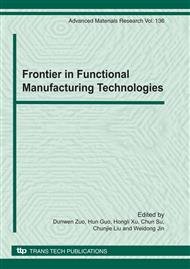p.33
p.39
p.43
p.48
p.53
p.59
p.64
p.69
p.77
Fabrication of Biodegradable Polymeric Micro-Analytical Devices Using a Laser Direct Writing Method
Abstract:
Microfluidic channel and micro-cavities were fabricated from polyhydroxyalkanoate biodegradable polymer using a direct 20ns, 248 nm excimer laser writing method. First we give a design of the micro-analytical device; second we discussed the laser ablation of biodegradable ppolymer material. The morphology, dimensional accuracy, and surface conditions of the fabricated micro-devices were studied using atomic force microscopy, scanning electron microscopy, optical microscopy, and X-ray photoelectron spectroscopy. Melting of the biodegradable polymer was observed at a fluency of 50mJ/cm2 while ablation was observed at a fluency of 100mJ/cm2.The different width between bottom and top surface are studied in our research. The particle deposited on the polymer surface is seen from the SEM of 248nm laser ablation of PHA. However, the direct burning of PHA can be seen from the optical photo by 355nm laser. Compare to results of PHA with two different lasers, we can see that the 248nm laser is a suitable choice.
Info:
Periodical:
Pages:
53-58
Citation:
Online since:
October 2010
Authors:
Price:
Сopyright:
© 2010 Trans Tech Publications Ltd. All Rights Reserved
Share:
Citation:


